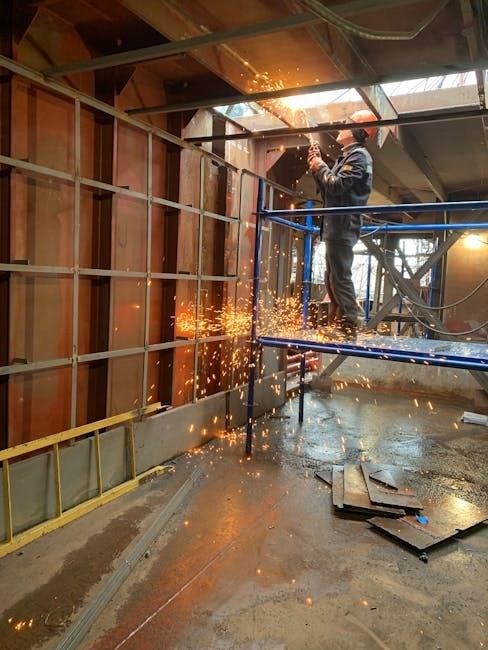Carefully unpack all components of the twin over full bunk bed. Compare all parts against the parts list provided in the instruction manual. Contact customer service immediately if there are missing or damaged pieces before proceeding with assembly.
Unboxing and Parts Inventory
Before commencing the assembly of your new twin over full bunk bed, the initial step involves a meticulous unboxing and inventory process. Carefully unpack all components from the shipping box, taking care not to damage any parts during this process. It is advisable to perform this task on a protected surface, such as a carpet or a drop cloth, to prevent scratches or other damage to the components.
Once unpacked, compare each item against the parts list provided in the instruction manual. This list typically includes all the wooden or metal frames, side rails, ladder, guardrails, slats, and the necessary hardware, such as bolts, screws, and washers. Verify that all the listed items are present and accounted for.
In the event that any parts are missing or damaged, it is crucial to contact customer service or the retailer immediately. Do not proceed with the assembly until you have received the necessary replacements. Attempting to assemble the bunk bed with missing or damaged parts can compromise its structural integrity and safety; Taking the time to conduct a thorough inventory at the outset will save time and frustration in the long run.
Tools Required
Before embarking on the assembly of your twin over full bunk bed, it is essential to gather the necessary tools. Having the right tools readily available will streamline the process and ensure a secure and stable final product. The most common tools needed include a Phillips head screwdriver, which is crucial for tightening various screws and bolts during the assembly.
An Allen wrench, often included with the bunk bed, is specifically designed for tightening bolts with hexagonal sockets. A rubber mallet can be helpful for gently tapping pieces together without causing damage. A measuring tape is useful for ensuring accurate alignment and spacing, particularly when installing side rails and guardrails.
Additionally, a level is essential for verifying that the bunk bed is perfectly horizontal and vertical, ensuring stability and preventing wobbling. A power drill with various drill bits can be used to pre-drill holes or to assist with tightening screws, but use it with caution to avoid over-tightening or stripping the screws. Work gloves can protect your hands during the assembly process, and safety glasses are recommended to protect your eyes from dust and debris. Gathering these tools beforehand will make the assembly process smoother and more efficient.

Preparation Before Assembly
Safety Precautions
Prioritizing safety is paramount when assembling a twin over full bunk bed. Before you begin, thoroughly read and understand all the manufacturer’s instructions and warnings. Ensure that the assembly area is clear of any obstructions and that you have ample space to work safely. It is highly recommended to have at least two adults assist with the assembly, as some components may be heavy or require simultaneous support.
Wear appropriate safety gear, such as safety glasses to protect your eyes from dust and debris, and work gloves to prevent hand injuries. Be mindful of the small parts and hardware, keeping them out of reach of children to prevent choking hazards. When using power tools, exercise caution and follow the tool manufacturer’s safety guidelines.
Avoid over-tightening screws or bolts, as this can damage the wood or strip the threads. Regularly inspect the bunk bed for any signs of damage or loose connections, and address them promptly. Ensure that the ladder is securely attached and that guardrails are properly installed on the upper bunk to prevent falls. Emphasize to children the importance of not jumping or playing on the bunk bed, and adhere to the recommended weight limits for both bunks. Following these safety precautions will help ensure a safe and successful assembly process.

Bunk Bed Assembly Steps
Assembling the Bed Ends (Headboard and Footboard)
Begin by attaching the side rails to the headboard and footboard. Ensure proper alignment and secure with bolts. Repeat this process for both the twin and full-sized bed ends, following manufacturer’s instructions for specific hardware.
Assembling the Bed Ends (Headboard and Footboard)
First, identify the components for the headboard and footboard of both the twin and full-size beds. Lay out all the parts on a protected surface to prevent scratches. Locate the necessary hardware, including bolts, washers, and screws, as specified in the assembly instructions.
Begin by attaching the side supports to the headboard and footboard posts. Align the pre-drilled holes and insert the bolts, securing them loosely with washers and nuts. Ensure that the supports are flush with the posts before tightening the bolts completely. Use the appropriate Allen wrench or screwdriver to tighten the hardware until snug, but avoid over-tightening, which could damage the wood or strip the threads.

Repeat this process for all four bed ends, ensuring that each connection is secure and stable. Double-check that the headboards and footboards are oriented correctly, with the finished sides facing outward. Once all the bed ends are assembled, inspect them for any loose hardware or misaligned parts before proceeding to the next step.
Keep the instruction manual handy for reference and ensure you have adequate space to move around the components. If you encounter any difficulties, refer to the diagrams provided in the manual or contact customer support for assistance.
Attaching the Side Rails
With the bed ends assembled, carefully position the twin-size headboard and footboard upright. Locate the side rails designated for the upper bunk. Align the metal brackets or wooden dowels on the side rails with the corresponding slots or holes on the headboard and footboard posts. Ensure the side rails are oriented correctly, with the safety rail facing upwards;
Firmly push the side rails into place, ensuring a secure and flush connection. If using metal brackets, insert the provided bolts through the brackets and into the pre-drilled holes in the posts. Tighten the bolts securely with an Allen wrench or screwdriver. For wooden dowels, apply a small amount of wood glue to the dowels before inserting them into the holes for a stronger bond.
Repeat this process for the full-size bed, attaching the appropriate side rails to the headboard and footboard. Double-check that all connections are tight and that the side rails are level. Use a level to ensure the side rails are aligned correctly, as this will affect the stability of the bunk bed. Once the side rails are securely attached, inspect the entire frame for any wobbling or instability before moving on.
If necessary, use additional hardware, such as screws or corner braces, to reinforce the connections. Consult the assembly instructions for specific recommendations.
Installing the Ladder
Carefully identify the ladder components included in the bunk bed kit. Typically, this will include the ladder rungs and the ladder side supports. Position the ladder against the side rail of the upper bunk, ensuring it is placed at a safe and convenient location for climbing. Most ladders attach to the bunk bed frame using metal hooks or brackets.
Align the ladder hooks or brackets with the corresponding slots or pre-drilled holes on the side rail. Securely attach the ladder to the side rail using the provided bolts and nuts. Ensure the ladder is firmly in place and does not wobble or shift during use. Tighten all bolts and nuts with a wrench or screwdriver until snug.
If the ladder comes with steps, make sure they are properly aligned and securely attached to the ladder frame. Check the stability of each step to ensure they can support weight safely. For added safety, consider using non-slip treads on the ladder rungs to prevent slips and falls.
Test the ladder by climbing up and down to ensure it is stable and secure. Double-check all connections and tighten any loose bolts or nuts. If necessary, adjust the position of the ladder for optimal safety and comfort. Once the ladder is installed, instruct children on the proper way to use it to avoid accidents.
Installing the Upper Bunk Guardrails
Locate all the guardrail components included in your twin over full bunk bed kit. Identify the left and right guardrails if they are specifically designed for each side. Position the guardrails along the perimeter of the upper bunk, ensuring they are placed at the designated locations as indicated in the assembly instructions. Most guardrails attach to the bunk bed frame using screws, bolts, or specialized locking mechanisms.
Align the mounting holes or brackets on the guardrails with the corresponding holes or slots on the upper bunk frame. Insert the screws or bolts through the mounting holes and tighten them securely with a screwdriver or wrench. Make sure the guardrails are firmly attached to the frame and do not wobble or feel loose. If the guardrails utilize a locking mechanism, ensure it is properly engaged to secure the guardrails in place.
Double-check that the guardrails are installed at the correct height and spacing to provide adequate protection against falls. There should be no large gaps between the guardrails and the mattress that could pose a safety hazard. Inspect the guardrails to ensure there are no sharp edges or protrusions that could cause injury.
Once the guardrails are installed, test their stability by gently pushing and pulling on them. If any movement or looseness is detected, re-tighten the screws or bolts until the guardrails are completely secure.

Final Checks and Safety Measures
Inspect every bolt, screw, and connection point. Tighten each fastener securely, ensuring no wobbling or instability. Double-check all connections, guaranteeing the bunk bed’s structural integrity and the safety of its occupants before use;
Tightening All Bolts and Connections
Once the bunk bed assembly is complete, the most critical step is ensuring all bolts and connections are meticulously tightened. This process is essential for the structural integrity of the bed and, more importantly, for the safety of anyone who will be using it. Start by systematically checking each bolt and screw used throughout the assembly process. Use the appropriate tools, such as wrenches or screwdrivers, to firmly tighten each one.
Avoid overtightening, which can strip the threads or damage the wood or metal components. Tighten until snug and secure. Pay close attention to the side rails, ladder connections, and guardrails, as these are critical support structures. Gently rock the bed to identify any loose joints. If movement is detected, revisit those connections and tighten them further.
After the initial tightening, allow the bed to settle for a few hours, then re-inspect all connections. Wood can compress slightly under pressure, so bolts may loosen. This second tightening helps ensure long-term stability. Finally, regularly check all connections, perhaps every few months, to maintain the bed’s integrity over time, preventing accidents.
Mattress Placement and Size Restrictions
After ensuring the bunk bed is structurally sound, proper mattress placement is crucial for safety and comfort. The upper bunk specifically has strict size restrictions to prevent falls. Always use a mattress that meets the manufacturer’s specified dimensions for both length and width. Typically, the upper bunk requires a twin-size mattress, while the lower bunk uses a full-size mattress.
The thickness of the upper bunk mattress is especially important; it must not exceed the maximum height indicated by the safety label on the bunk bed frame. This ensures the guardrails remain effective in preventing someone from rolling out of bed. Using a thicker mattress compromises the guardrail height, increasing the risk of injury.
When placing the mattresses, ensure they fit snugly within the frame. Gaps between the mattress and the frame can create entrapment hazards. Do not use makeshift solutions to fill gaps. If a perfect fit isn’t possible with standard sizes, consult with the manufacturer for alternative options. Regularly check the mattress placement to ensure it remains secure and within safety guidelines.
Safety Guidelines for Use
Following safety guidelines is paramount for preventing injuries associated with bunk beds. Never allow children under six years old to use the upper bunk. Young children lack the coordination and awareness needed to safely navigate the ladder and bunk bed environment. Always use the ladder provided for climbing in and out of the upper bunk, and ensure it is securely attached to the frame.
Discourage horseplay or jumping on the bunk beds, as this can destabilize the structure and lead to falls. Limit the number of occupants on the upper bunk to one person at a time. Exceeding the weight limit can compromise the bed’s structural integrity. Prohibit hanging items, such as belts or ropes, from the bunk bed, as these pose a strangulation hazard.
Instruct children on proper ladder usage, emphasizing the importance of facing the ladder and using both hands for support. Regularly inspect the bunk bed for loose bolts, damaged parts, or sharp edges. Promptly address any issues to maintain a safe sleeping environment. Ensure sufficient lighting around the bunk bed area to improve visibility, especially at night.


